Heather ‘Bird’ Harris is an Atlanta-based artist and educator who prioritizes caretaking and connection. Her work explores the throughlines between history and ecological crises, engaging with communities, scientists, and site-specific materials to investigate land memory, systems of complicity, and possibilities for emergence. Her recent body of work, “love as large as grief demands,” transforms mapped industrial scars in Georgia and Louisiana into regenerative landscapes made with site-specific materials. Through shapes that can either build the future or jeopardize it— mycorrhizal webs, children’s drawing, coal and soil runoff, heliotropic growth —the works offer personal reflections on what hangs in the balance and what’s in our water, emphasizing the necessity of imagining possibility grounded in the physical histories of our landscapes.
"For these pieces, I used site specific material and water for the first layers, monoprinting one side with the other (as the past affects the future) and following the material’s lead," says Bird. "No matter how it dried, I forced myself to not scrap it and find a landscape within it to build from. I added painted and collaged details that felt like a brain dump of what’s hanging in the balance. I tried to practice the necessity of imagining possibility, grounded in the physical reality of a landscape. I was also thinking about these works as a response to what American landscape painting helped to create, replacing its fantasized dominion with an undoing of harm. The paintings look down aerially onto the shape of how we’ve gotten it all wrong, while holding space for a view of what a horizon might look like if we got it right. This process of creating is also the task of mothering today: take what you’ve been handed, build a survivable world within it -- and make it as beautiful as possible."
"300 Years of Georgia," watercolors made with clay, ochre, and weathering rind found in Georgia, manganese brown pigment, watercolor, water, paper mounted on panel, protected with beeswax, 64 by 120 inches
We see Georgia red clay everywhere, but it shouldn’t be visible at all. The subsoil should be under the cover of a meter of organically rich Black Belt topsoil, as it was in the early 1800s and for thousands of years before that. Plantation economics and monocultures drained the health of the soils and their capacity to grow new life, resulting in one of the most significant environmental disasters in the state's history. In the 1930s, the Soil Conservation Service distributed 70 million kudzu seedlings as a “miracle cure,” paying farmers $8 per acre to plant them in an attempt to stop the land loss.
In less than 200 years, the Piedmont lost an average of 7 inches to over a meter of topsoil. It takes 100 years to regenerate one inch of topsoil under ideal conditions, meaning it would take 4,000 years to regenerate what white settlers destroyed in 200.
The evidence is pervasive, even covering the bottom of our shoes, following us as we walk — a ghost of a harmful history we never repaired. How can we imagine a healthier future if we don’t remember what color our soil should be?
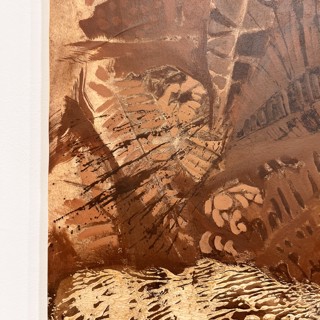
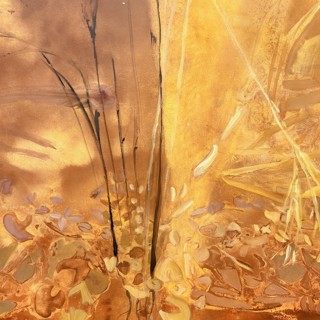
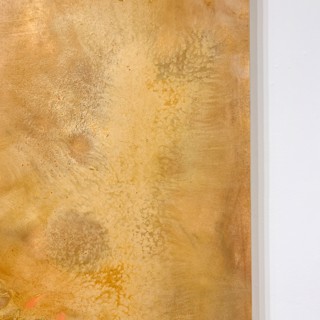
"Coal Ash Permeation (Plant Hammond)," watercolors made with coal from a shipwrecked coal-burning vessel, weathering rind and clay found in Georgia, watercolor, oil, paper mounted on panel, protected with beeswax, 64 by 48 inches
This painting takes the shape of Ash Pond 3, a 25- acre mound part of the retired Plant Hammond power plant along the Coosa River in Rome, Georgia. What appears to be a benign grassy hill conceals one million tons of coal ash buried in an unlined landfill, where toxins are leeching into the groundwater below. Coal ash, the toxic byproduct of burning coal, contains carcinogens and neurotoxins that threaten human health, particularly in children. Plant Hammond is one of 29 unlined coal ash disposal sites in Georgia, a legacy of the state’s prolonged dependence on coal and its mismanagement of hazardous waste.
Created with coal and weathering rind, materials shaped over millions of years, Coal Ash Permeation envisions a deep-time landscape enduring beyond the toxins, with fractals of life reaching toward renewal and balance.
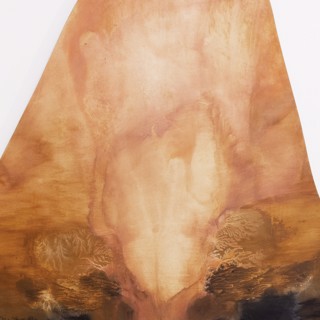
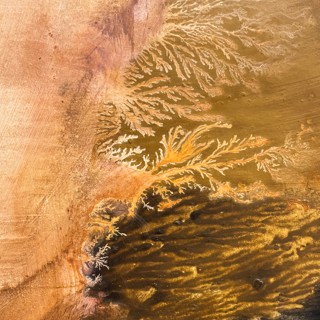
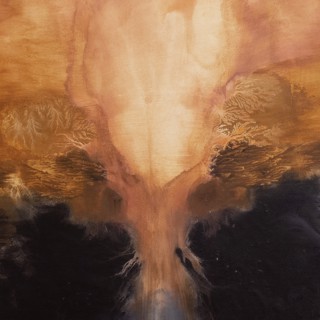
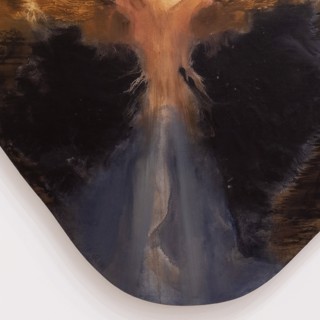
"Life Support (GTS Data Center)," watercolors made with clay and weathering rind found in Georgia, copper oxide, watercolor, acrylic, paper mounted on panel, protected with beeswax, 56 by 48 inches
This painting takes the shape of the QTS Data Center, under construction in Fayetteville, Georgia, where 615 acres of forest are being cleared to make way for the world’s largest AI and data storage facility. Attracted by Georgia’s tax breaks for data centers, these facilities consume up to 200 million gallons of water annually, straining Georgia’s rivers —as seen in Douglasville, where one Google data center diverts 30% of the town’s water.
To meet the soaring energy demands of these centers, Georgia Power recently reversed its plans to retire coal plants, doubling down on fossil fuels and compounding environmental harm. This renewed reliance on coal, paired with massive water diversion, exacerbates water scarcity and undermines efforts to combat climate change.
Life Support reimagines the QTS site through materials sourced from Georgia’s land, where clay and water used to sustain a garden, instead. The painting includes images of the first colonist's drawings of Georgia wildlife in the 1730s, strung-up dead birds and long-gone native plants,
highlighting the destructive legacy of colonization and its continuation in modern systems of capital over care. These are juxtaposed with the artist’s children’s drawings of flowers, butterflies, and their family home, offering a vision of life flourishing beyond extraction. The landscape resists the erasure of the natural world, suggesting a future where our resources support life rather than industry.
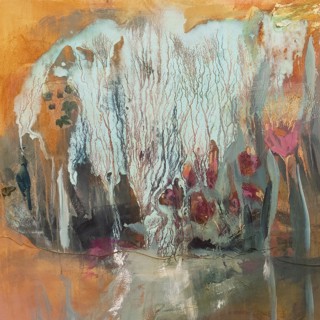
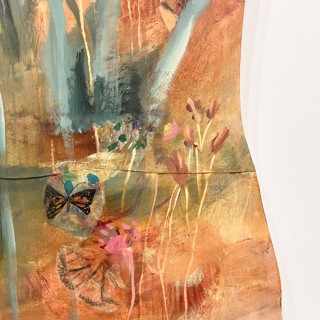
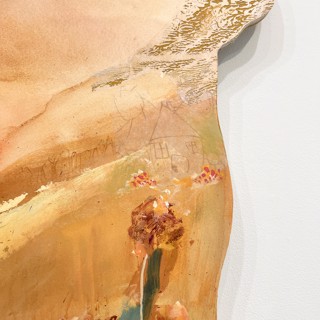
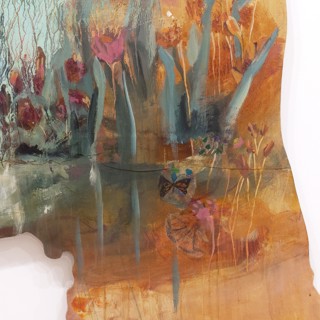
"The Power of Hydrogen: Georgia’s Rivers," archival pigment print on paper on panel (macro scans of neutral water (L) and alkaline water (R) mixed with ink from:
white oak acorns, buckvine + yaupon, wild blueberries, buckvine, and yaupon all found in Atlanta, Georgia. 51 by 118 inches variable
Over the past 60 years, rivers in the eastern United States have become significantly more alkaline from road salt, fertilizer runoff, fracking brine, and other man- made contaminants. This shift disrupts freshwater ecosystems, threatening the delicate balance needed to sustain life. This installation uses pigments from native Georgia plants to make the invisible changes visible. The resulting color shifts illustrate how human activity is affecting our watersheds and all living beings that depend on them.
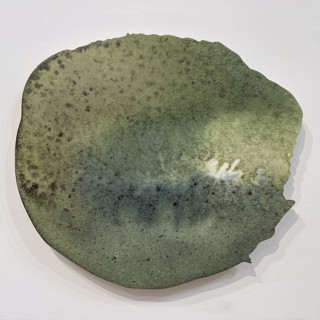
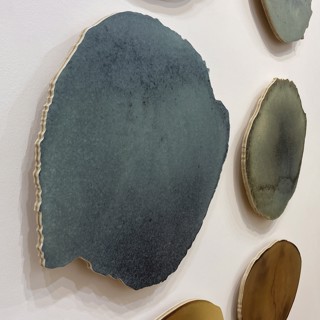
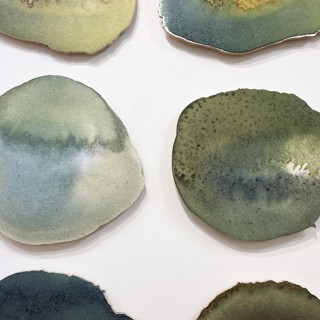
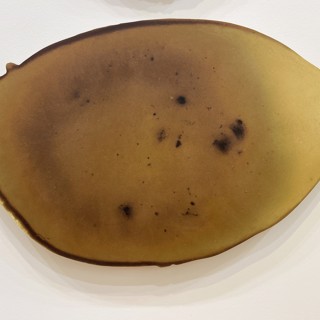
"Entropic Possibilities and the Impossibility of Cop City," watercolors made with clay and weathering rind found along the South River in Atlanta, walnut ink, watercolor, oil, paper mounted on panel, protected with beeswax, 64 by 48 inches
This painting reflects the shape carved from the Weelaunee Forest, where 381 acres of trees were clear cut for a $106 million police training complex in DeKalb County, Georgia, where I live. The facility includes a mock city for urban warfare training and plans to host the Israeli Defense Forces and other military units through the Georgia International Law Enforcement Exchange (GILEE). Despite opposition from over 116,000 Atlanta residents, Mayor Andre Dicken’s administration has refused to count their signatures, fast- tracking construction and holding a ribbon-cutting ceremony for the facility last month.
Beyond its role as a site of state violence, Cop City also poses a climate risk, causing flooding in surround neighborhoods, erasing one of Atlanta’s four lungs, increasing soil runoff into the South River watershed, already one of the most endangered rivers in America.
This is not isolated to Atlanta. Since the global uprising after the murder of George Floyd almost 5 years ago, there has been a quiet rollout of over 80 multi-million dollar Cop City-like facilities across America, in every state so far except Wyoming, Vermont, and North Dakota. This is our country’s answer to working- class coalition-building across party lines, and it is the scariest part of the horizon for me.
Although the fascist realities before us seems impossible to navigate at times, what’s actually impossible is a system that defies how nature sustains itself. The law of entropy in thermodynamics says that all isolated systems trend toward “disorder,” which posits “nature” as the opposite of human-imposed order. In this sense, entropy is not only inevitable but also positive—a veering away from systems of control that have repeatedly failed us. As mathematician Wissner-Gross describes it, entropy can also be seen as the "physical process of trying to capture as many future histories as possible," emphasizing potential, adaptability, and the natural stasis of all life matter which seeks expansive space and resists imposed order.
I struggled to make this painting beautiful. My goal was to transform the shape we’ve inherited and imagine a generative world within it, and part of that was committing to not scrapping it mid-way, just working with what I had. At a particularly dark point, I asked my kids to draw directly on the painting. We had hiked together near Lake Charlotte, one of the closest walking trails to Cop City still accessible to the public, to collect the soil for this painting. I asked them to picture what that land would look like if it was happier. They drew flowers, multiple suns, mushroom cupcakes, and hearts. My son added houses on a plateau, reminding me that, “people can live responsibly with nature too, Mom.” I added the flyers he made for the Palestinian encampment at Emory last spring, where my students and I witnessed the oppression of peaceful protest first hand.
For me, the artistic insistence on a livable, beautiful future is the same work as mothering. The landscape we made together resists ruin, as we will continue to do.
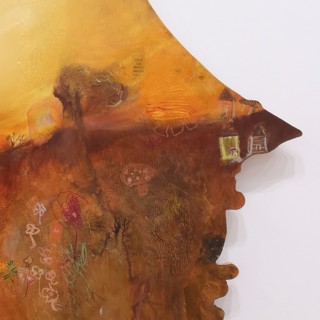
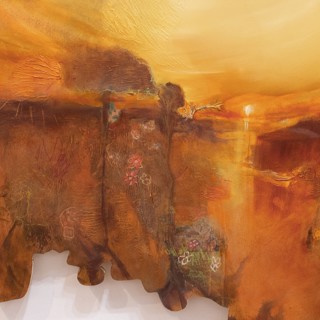
"Forever Changing (beyond DuPont)," indigo gouache, copper oxide, green earth, ochre, watercolor, paper mounted on panel, protected with beeswax," 64 by 60 inches
This painting takes the shape of the DuPont chemical company’s mapped footprint, surveilled from above. For decades, DuPont and other manufacturers in Dalton, Georgia have polluted the drinking water downstream with PFAS, or “forever chemicals”. These man-made compounds do not break down over time, instead accumulating in the bodies of 97% of Americans and all living beings.
Drawing its title from Octavia Butler’s Parable of the Sower, the painting reimagines this site of harm as a regenerative future landscape that persists alongside PFAS, forever changed and still growing in fractals towards right relationship and the sun.
“Create no images of God. Accept the images that God has provided. They are everywhere, in everything. God is Change— Seed to tree, tree to forest; Rain to river, river to sea; Grubs to bees, bees to swarm. From one, many; from many, one; Forever uniting, growing, dissolving— forever Changing. The universe is God’s self-portrait.”
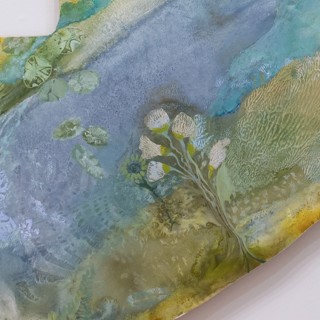
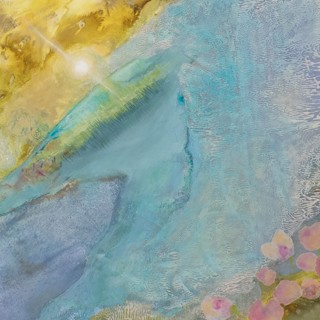
"Spilhaus Plastisphere," copper oxide, watercolor, salt, green earth, plastic wrap, paper mounted on panel, protected with beeswax, 64 by 45 inches
Based on the Spilhaus projection, this painting shows the world’s oceans as they are: one vast, interconnected body of seawater. Overlaid onto this map are six plastic circles in the ocean’s gyres, where swirling currents have accumulated the world’s plastic debris to form massive “garbage patches”. These patches—two in the Atlantic, one in the Indian Ocean, and three in the Pacific (one measuring twice the size of Texas)—have spawned plastispheres: human-made ecosystems where microorganisms colonize plastic waste, generating new forms and materials – enduring fossils of capitalism’s shortsighted obsession with efficiency.
Rendered with copper oxide, a conductive and toxic material, the painting symbolizes the connective tissue of water and the invisible toxins it's been forced to carry. This remapping invites a reframing of our relationships, emphasizing our water's interconnectedness and how local crises ripple globally, revealing the inextricable ties between our bodies, water, and pollution.
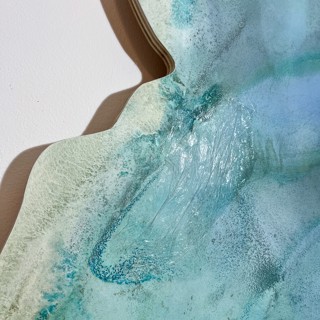
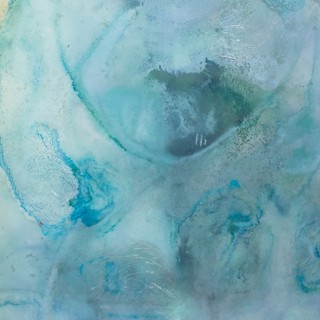
"Euclidean Unlearning," watercolor made from green earths, ochre and indigo, gouache, paper mounted on cradled panels, protected with beeswax, 24 by 24 inches
Euclidian Unlearning depicts a horizon and its inverse, twin suns suspended above and below, fractal patterns spiraling outward, and decomposing leaves rendered in green earth pigments and water. The painting deliberately abandons the rules of Euclidian space, an ordered presentation of space that echoes Enlightenment-era ideals that human control over nature is possible and beneficial. Instead, the composition suggests that time is not a march toward progress but a cyclical interplay of decomposition and growth.
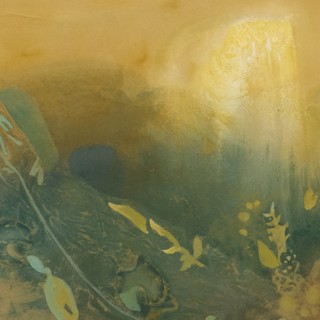
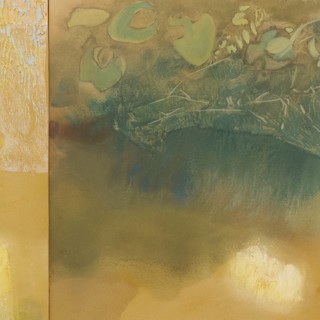
"How To Begin Again," watercolors made from Georgia clay, green earths, and ochre, walnut ink, gouache, paper mounted on cradled panels, protected with beeswax,
42 by 20 inches
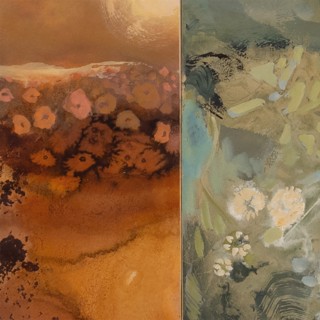
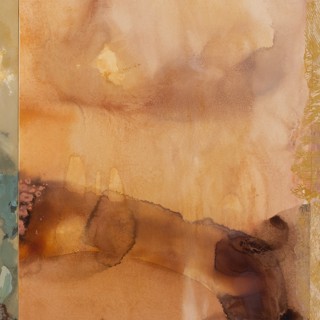
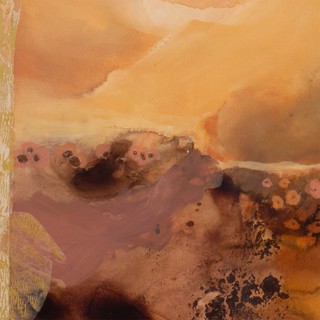
"Affordances of Water (Atchafalaya Basin)," clay found in a tributary of the Mississippi River, red ochre, gouache, and water on Saunders 640 gsm paper, 60 by 40 inches, 63.5 by 43.5 inches framed
Since the 1920s, Louisiana’s coastline has been disappearing at a rate well- known by locals: a football field every 45 minutes. But just south of Morgan City, the Atchafalaya Bay defies this trend, building over a square mile of new land annually. Unlike the Mississippi River, which is tightly controlled by levees that funnel sediment into dead zones in the Gulf of Mexico, the mouth of the Atchafalaya River is allowed to flow freely. Its natural course deposits sediment into healthy wetlands in the Atchafalaya Bay, demonstrating the resilience of ecosystems when allowed to operate without human interference. This painting mirrors the Atchafalaya’s geologic processes: water carried clay pigment across the surface until it settled naturally, forming tributaries and islands. By allowing the materials to follow their own course, the work evokes the pre-colonial fluidity of landscapes.
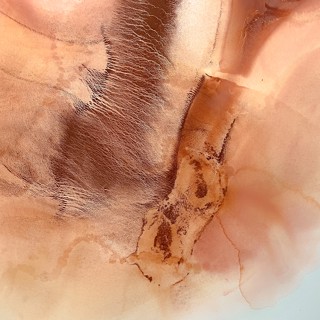
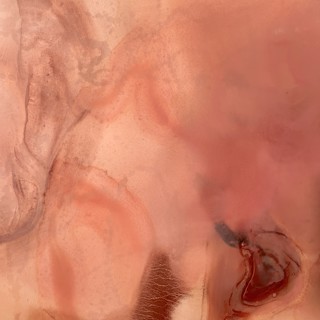
"Until It’s All Gone (Venture Global LNG)," clay found in a tributary of the Mississippi River, red ochre, gouache, and water on Saunders 640 gsm paper, 60 by 40 inches, 63.5 by 43.5 inches framed
Near the mouth of the Mississippi River in Plaquemines Parish, Louisiana, a petrochemical company is currently constructing a $21 billion liquid natural gas (LNG) plant. It has surrounded the facility with a 26-foot-high steel sea wall, as if to say that they are prepared to be the last ones standing. The Louisiana coast is losing land into the sea faster than anywhere else on earth, in large part due to the extraction and burning of these fossil fuels. These
companies have caused the planet to warm, the storms to become more destructive, and the water to rise. And yet their presence is growing within taller walls, forsaking the communities they employ. This petrochemical fortress is on track to become a steel island rising from the depleted, sunken earth, a fossil of our fucked priorities.
I finished this work as Hurricane Milton approached the Florida coast as a category 5, and found myself just staring at the shadows in the goldenrod. My girlfriends in New Orleans texted that they are pacing their backyard and lying in the grass, feeling helpless and searching for reserves. So the ground holds us, the soil remains beautiful, and it will outlast all of this. Since we are part of it, we can too.
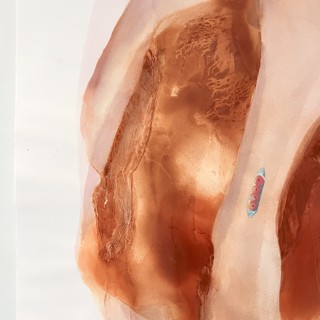
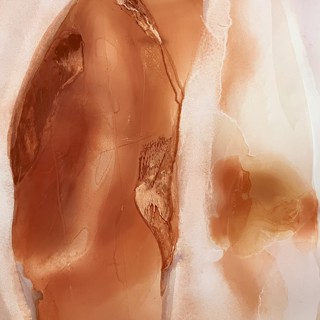
“Remember you are water. Of course you leave salt trails. Of course you are crying. Flow. If there happens to be a multitude of griefs upon you, individual and collective, or fast and slow, or small and large, add equal parts of these considerations: that the broken heart can cover more territory. that perhaps love can only be as large as grief demands. that grief is the growing up of the heart that bursts boundaries like an old skin or a finished life. that grief is gratitude. that water seeks scale, that even your tears seek the recognition of community. that the heart is a front line and the fight is to feel in a world of distraction… that the sacred comes from the limitations. that you are excellent at loving.” ― Adrienne Maree Brown, Emergent Strategy: Shaping Change, Changing Worlds
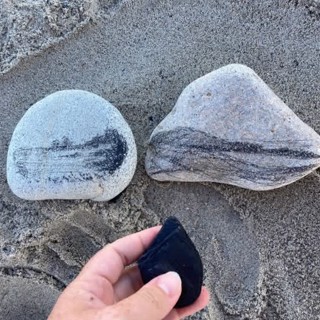
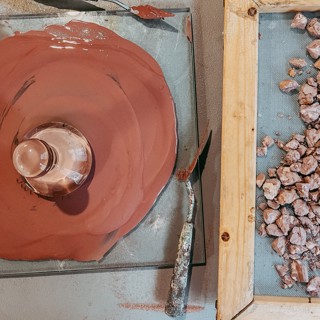
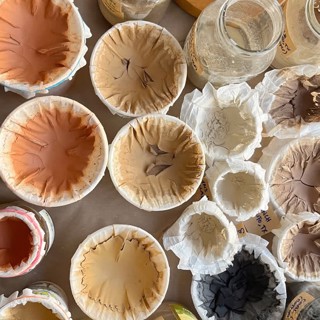
Heather Bird Harris received her B.S. in art history from Skidmore College and master’s degree in education leadership from Columbia University. She has served as principal of a turnaround school in New Orleans and has consulted with school leaders across the South to implement equitable learning practices and anti-racist history education. Recent exhibitions include NADA Curates, the New Mexico State University Museum, SITE at the Goat Farm (Atlanta, GA), Art Fields (Lake City, SC), Stoveworks (Chattanooga, TN), the Barnes Ogden Gallery at Louisiana State University, and Science Gallery Atlanta. She has been an artist in residence at the Cary Institute of Ecosystem Studies (Hudson Valley, NY), The Hambidge Center (Rabun Gap, GA), and was one of 7 artists selected for the Art & Social Justice Fellowship at Emory University in 2023. Current projects include Sonoran Heritage Waters with musicians and ecologists at Arizona State University and Hope Springs Eternal in collaboration with activist group RISE St. James and New Orleans-based artists. Harris is an MFA candidate at Georgia State University. She lives in Atlanta with her partner, Josh, and their two children.
AVAILABLE WORKS
PRESS
